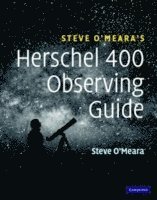
- Format
- Inbunden (Hardback)
- Språk
- Engelska
- Antal sidor
- 380
- Utgivningsdatum
- 2007-06-01
- Upplaga
- illustrated ed
- Förlag
- Cambridge University Press
- Illustratör/Fotograf
- 427 halftones
- Illustrationer
- 427 half-tones
- Dimensioner
- 283 x 225 x 28 mm
- Vikt
- Antal komponenter
- 1
- ISBN
- 9780521858939
- 1600 g
Herschel 400 Observing Guide
How to Find and Explore 400 Star Clusters, Nebulae, and Galaxies Discovered by William and Caroline Herschel
Slutsåld
Kundrecensioner
Recensioner i media
'O'Meara takes a list of admittedly faint objects and injects new life into them. Right or wrong, many amateur astronomers won't consider you a top-level observer until you've completed the Herschel 400. Don't do it for them, however. Pick up this book, set up your telescope, and do it for yourself. It's a lot of fun.' Michael Bakich, Astronomy.com
'This book is a great way of pushing beyond the popular Messier catalogue to broaden your viewing horizons.' Paul Money, Sky at Night
'[This book] is a far better guide to the Herschel objects than the one available from the AL. It is well presented ... to be recommended to observers looking for an organized project with medium-sized telescopes after completing the Messier list.' Owen Brazell, The Observatory
'The Herschel 400 Observing Guide is a very good book, whose main strength is its instructions for locating objects. Even if you are not interested in seeing all of the Herschel 400 objects, I recommend it as a good mid-range guide to the deep sky.' Lee Macdonald, Journal of the British Astronomical Association
'This book is very nicely produced ... The layout is very well thought out ... [O'Meara] works through the objects in a carefully planned and methodical way, ensuring that the minimum of telescope time is employed in locating objects and in moving from one object to the next.' Alex Crowther, Astronomy and Space
'A good resource for anyone wishing to explore the deep sky.' Astronomy Now
Övrig information
Steve O'Meara earned a Bachelor of Science degree from Northeastern University and has spent much of his career on the editorial staff of Sky & Telescope magazine.The Texas Star Party gave him its Omega Centauri Award for 'advancing astronomy through observation, writing, and promotion, and for his love of the sky,' and the International Astronomical Union named asteroid 3637 O'Meara in his honor. Among his many astronomical achievements, he was the first to sight Halley's Comet on its 1985 return; he noticed the dark 'spokes' in Saturn's B ring before the Voyager 1 spacecraft imaged them; and he was the first person to determine the rotation period of the distant planet Uranus. A superb writer, photographer and naturalist, Steve O'Meara enjoys traveling the world with his wife, Donna Donovan O'Meara, to document volcanic eruptions. Their work has appeared in the National Geographic magazine, and on television. He is sought after internationally for his dynamic lectures on astronomy and volcano topics. Steve is also a contract videographer for National Geographic Digital Motion.
Innehållsförteckning
Preface; Introduction; Part I. Winter: 1. January; 2. February; 3. March; Part II. Spring: 4. April; 5. May; 6. June; Part III. Summer: 7. July; 8. August; 9. September; Part IV. Fall: 10. October; 11. November; 12. December; Appendix A. Herschel 400 observing list; Appendix B. Herschel 400 checklist; Appendix C. Photo credits; Index.
Du kanske gillar
-
Orbital
Samantha Harvey
Häftad
